Survival School Class Descriptions
CERTIFICATION PROGRAM
Upon completion of a workshop/class series, a Certificate of Completion will be issued, upon request. Completing 6 different workshops/class series qualifies an individual to work towards a Self-Reliance Skills Specialist Certification.Ask us for details.
When you sign up in advance for any series of 4 classes, one of the classes will be free. (You will still be able to join any of the individual classes of the series.) Each series of 4 classes will repeat.
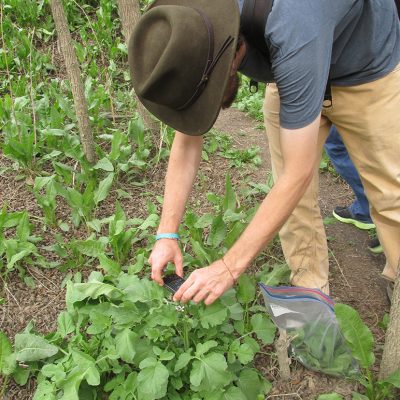
Foraging Classes Los Angeles
Learn how to forage for and identify wild edible plants in Los Angeles, LA County, and all of Southern California from the author of the definitive book on Foraging in California
ETHNOBOTANY series:

Plant ID/ plant presses:
Learn how to make a plant press, how to record plants you’ve found, and basic botanical terminology.
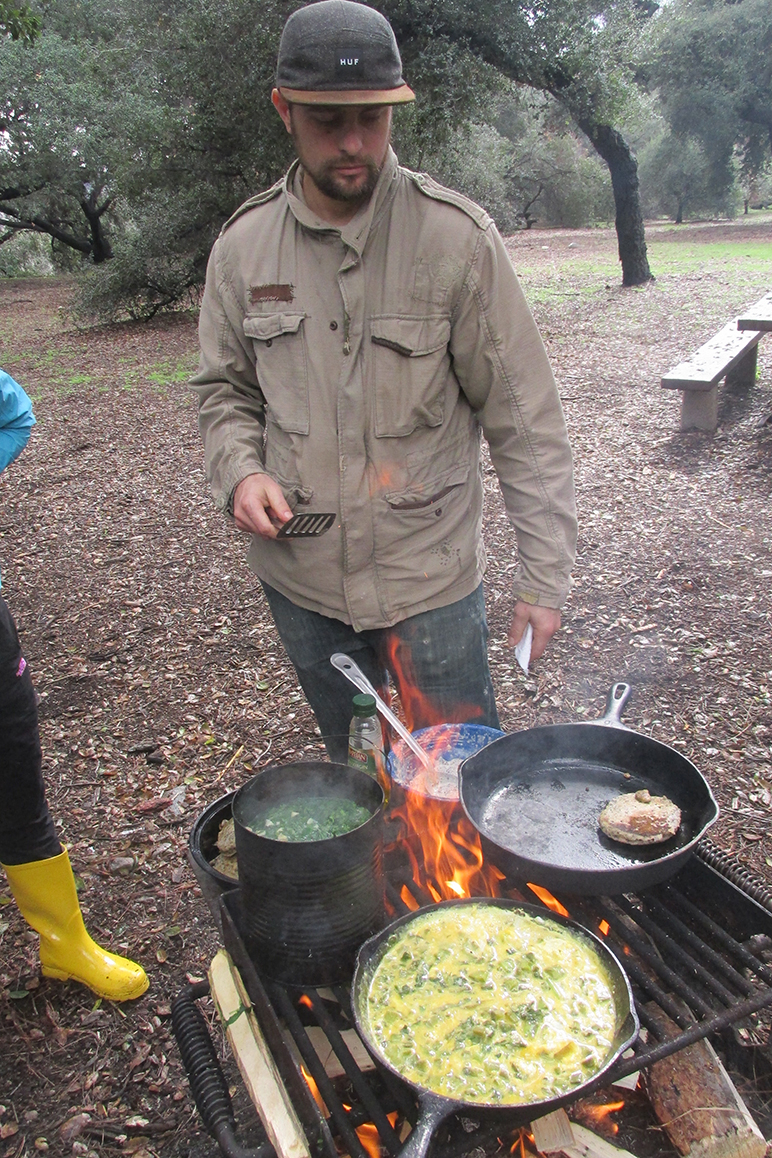
Edible soups and salad:
We’ll do a short walk and collect some of the in-season wild foods and then we’ll prepare them to a simple meal of soup, pancakes, salad, etc.
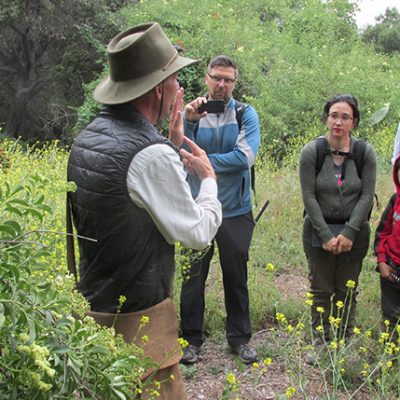
Medicine:
You will learn about the traditional medicinal plants used for some of the most common ailments, as well as actual testimonials. This is not a sharing of undocumented folklore! We will focus upon the locally-occurring medicinal plants, and how to use them.
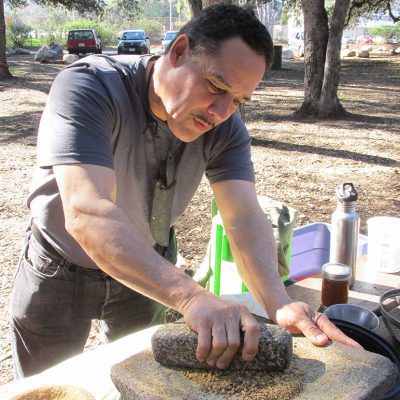
Acorn-processing:
Learn how to process acorns, from the raw acorn to the plate of fresh pancakes! You’ll shell the acorns, grind, sift, leach, and mix into a batter and make pancakes, all during our class time. We’ll also try a few other wild foods during this class.
WEEKEND WARRIOR - PRIMITIVE SURVIVAL SKILLS series:
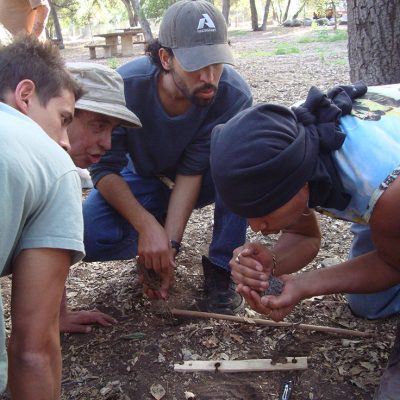
Primitive (and beyond) fire-making:
We cover the necessity for fire, and a complete overview of the methods to produce a fire, based on the four principles of fire-making [Friction, Electricity, Chemicals, the Sun]. Class includes learning how to select the woods for two style of friction fire-methods, creating a kit, and making a fire.
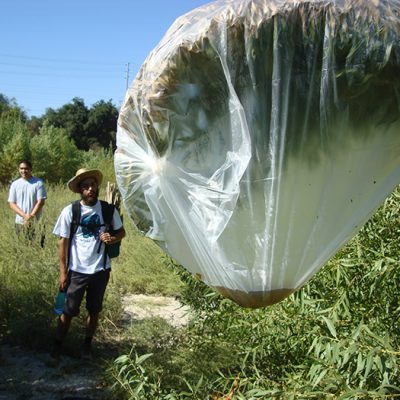
Water:
You will learn all about finding, purifying, and storing water. Water procurement includes the solar still, transpiration bag, wells, and dew collecting. You will learn what it takes to purify suspect water, and how to purify water with the sun.
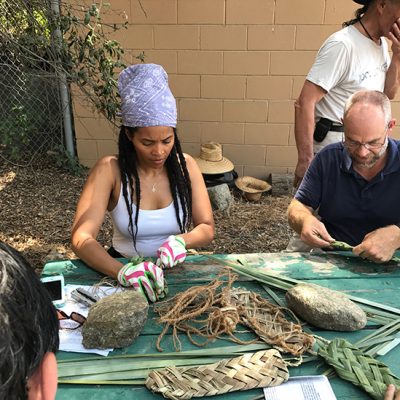
Fibre:
You will learn about the plants which produce fibre, and how to process those plants to make cordage, making sandals, brushes, and other useful items. You will also learn how to produce an expedient net. You’ll never look at rope and cordage the same!
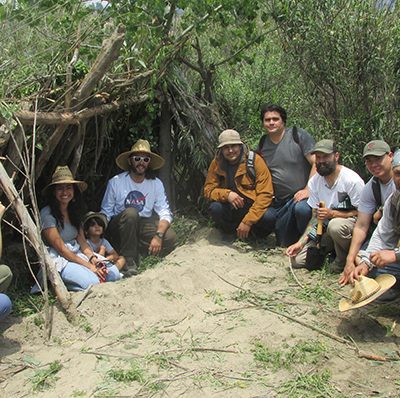
Shelter:
In this class, you’ll learn about both modern and wilderness shelters. You’ll get to set up a few modern shelters, and then we’ll work on a few of the more traditional sorts of shelters that you’d construct strictly from the wild. These include the body hollow, the lean-to, and the half-dome shelter. You’ll also discover various ways to stay warm on your bed in such shelters. Class includes a walkabout, and hands-on experience.
URBAN PREPAREDNESS AND SURVIVAL SKILLS series:
This series shares the practical skills for dealing with the aftermath of urban emergencies/ disasters. In addition to the 4 basic topics listed her, we can address other emergency planning, such as First Aid, shelter alternatives, and “hardening” your home space to protect from mauraders.

Food and Shelter:
In this seminar/class, we cover the basics of food storage and how to do it economically. Remember, if the power is out, your refrigerated food will go bad soon. Learn how to buy food that can be stored without electricity. Also, if you have a yard, you should always be able to get some of your food from your own yard. Learn how to make shelter from ordinary household items. Do you have a Neighborhood Watch, CERT, or other local group? Food trading from your own neighbors is another way to ensure your food supply, as well as supporting local Farmers Markets.
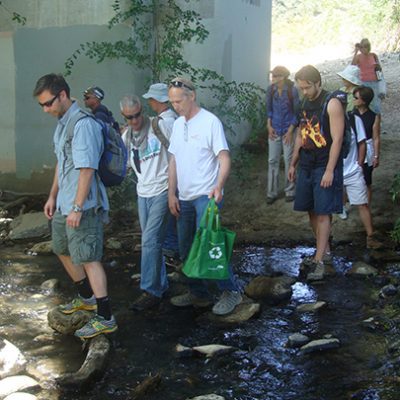
Water storage, purification, and rationing:
If you live in Los Angeles County, you know that only about a quarter of our water is local. The rest of our water comes to us from hundreds of miles away, and could be disrupted by an emergency. Learn how to store water for ready use. Learn how to collect rain water. Discover all the sources of water in your home and neighborhood. Also, discover where all the water once flowed, and might still be there today. This class also includes how to make a toilet if you no longer have water for your indoor unit.
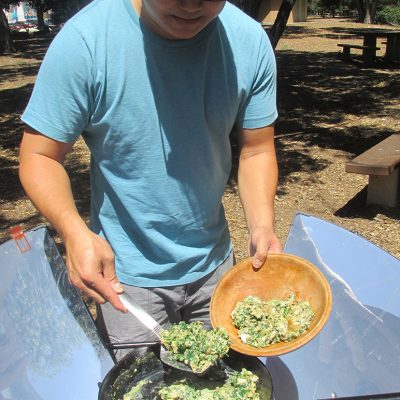
Cooking outside, under the sun, or night sky:
If your stove is no longer working because you don’t have natural gas or electricity, you should know how to cook meals in your backyard, with camping stoves and little wood stoves. Learn how to provide your own fuel. Much of the Third World, where cooking has long been done with fire, has slowly moved to cooking with the sun, using simple technologies. The two basic solar cookers are the enclosed oven which holds the heat, and a reflector, which focuses the sun to a point. We show both methods, and students will construct a low-cost solar oven.
Alternatives to electricity and emergency power sources:
People lived without electricity for millenia. We can do the same if our electricity wasn’t available. First, learn all the ways in which jobs you now do with electricity can be done manually, with existing tools. Then learn how to generate and store electricity. We’ll focus mostly on solar electricity, and batteries. What are the alternatives to electrical lighting? What about communication methods after an earthquake?
SELF-RELIANCE RESOURCE GARDEN series:
Wild Food Garden Patch:
Learn how to produce a wild food garden in your own backyard, so you can do your own backyard foraging with plants you know are safe. You will learn the Die-Hard Dozen that will grow throughout urban areas, everywhere. You’ll also learn what will grow in your area, and how to cultivate and preserve them for year-round food resource.
Native American Medicinal Plant Garden:
Learn the medicinal plants of Native peoples in California, and learn how to properly select, grow, and care for these resourceful plants. Learn which plant parts are used for the Healing Arts.
Edible Landscaping:
Learn what food plants of the world grow well, and look like ornamental landscape plants in your yard. Learn how these landscape plants will serve you well in emergencies while supplying food year-round.
Useful Medicinal Vegetables of the World:
Your best medicine is your food. Learn about the amazing nutritious plants which could grow in your yard for you to eat for your health.
WILD FOOD AND USEFUL PLANTS BY THE SEASON, series:
This is a series of workshops, one per season, so you can learn to see nature through the seasons, from a forager’s perspective.
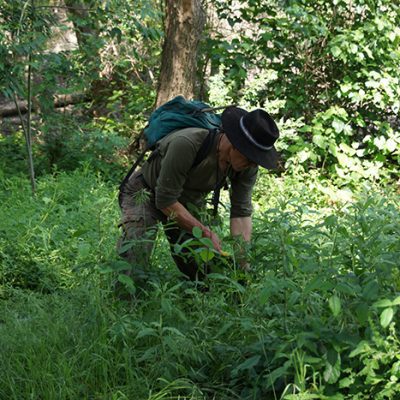
The essence of this class is to develop seasonal knowledge and observational skills: How to look, where to look, what to look for. Plus, we will also focus on responsible and sustainable gathering methods, including collection of seeds and cuttings so you can grow plants in your own backyard.
You’ll learn how to identify and collect foods, medicines, soaps, fire-materials, and other useful parts of plants. You’ll learn to think like foragers of the past, who had to have an intimate knowledge of the seasons, and foresight for the future. (For example, sometimes you do NO foraging in an area if the plant or seed is not abundant.)
Join us each quarter for an insightful walk into a wild area, with a focus on interpreting what’s available that season. Each session will include demonstrations, hands-on practice, and sampling of the seasonal foods, such as salad, soup, biscuit, or tea. Each session includes a list of what is normally available in that season.
BUSHCRAFT series
Complete any 4 classes on the List of Individual Classes under the Bushcraft category within two years to earn a certificate in this category.
INDIVIDUAL CLASSES, held throughout the year:
WILD FOOD, MEDICINAL, AND USEFUL PLANTS
Have you ever wondered how to use wild plants for food? We will show you how to identify the many common plants growing everywhere, and how to use them for food and medicine. In our various wild plant classes, we will take short walks and sample some of the common wild edibles in salads, soups, or teas. You will also learn how to identify the many plants used for generations in the past for making fire, weapons, cordage, and more.
Classes in this category include the following:
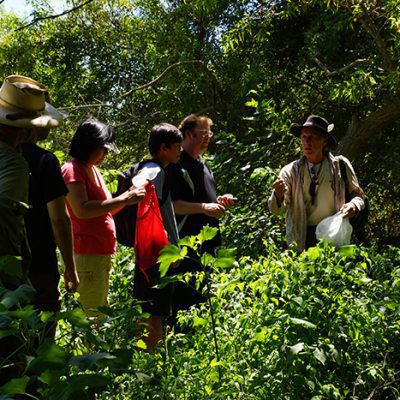
Wild Food Outings:
This is our basic plant walk where you learn to identify whatever plants we encounter. We will collect some of the edible plants that are in season, so we can make a sample salad for you to taste. Where possible, we’ll also make a simple soup from freshly-collected plants. Bring your bowl.
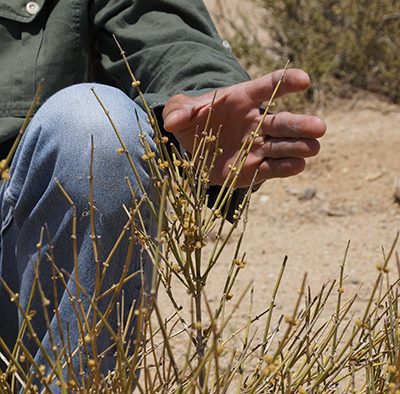
Medicinal Plants Walks:
These walks emphasize the identification of medicinal plants, and how to use them for treating common ailments. You will learn about infusions, decoctions, and various preparations and preservations of herbs.
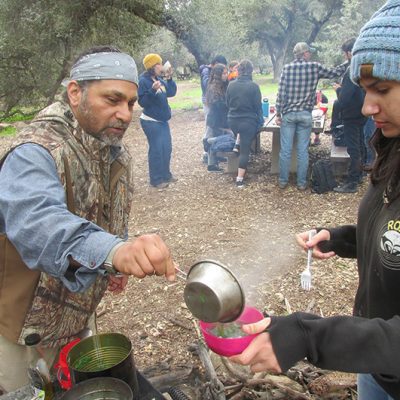
Wild Food Cooking Workshops:
The popular Cooking workshops involve a walk where we first explore a given area and collect an assortment of plants that are currently in season. Then, we go back to our tables and cook area, and involve everyone in the preparation of a meal, using what we just collected as well as previously-collected plants. The meal will typically include a salad, soup, tea, mixed stew, egg and cactus dish, pancakes with wild grains, and some sort of dessert item. Bring your cup and bowl.
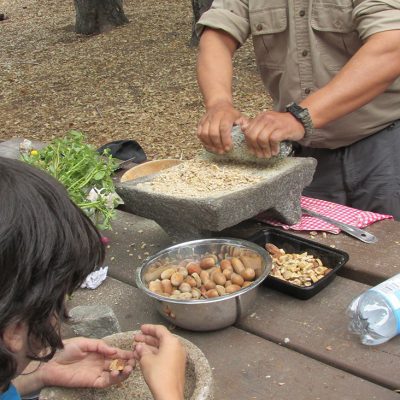
Acorn processing workshop:
In this stand-alone class, you will have the opportunity to create food from the acorns, from A to Z. You will learn by doing! You will shell the acorns and learn to differentiate good acorns from inedible ones. You will grind and sift the acorns, and leach the tannic acid out of the acorn flour. When fully leached of the tannic acid, you will blend with conventional flour, and make pancakes. Bring your bowl.
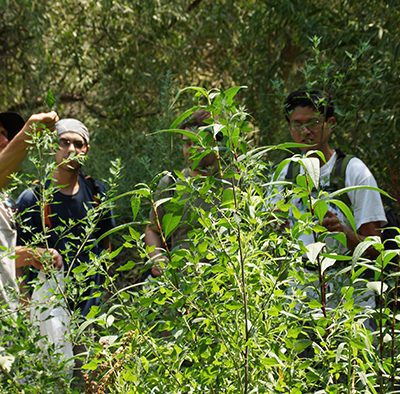
Useful plants walk:
During these leisurely walks, you will learn about the full spectrum of uses from the Plant Kingdom, including food, medicine, soap, fibre, perfumes, fire-making, poisons, and more. Though we don’t always make a sample salad on this walk, bring your bowl just in case.
BUSHCRAFT and PRIMITIVE SKILLS
Knives, and knife sharpening:
With all the knives currently being manufactured, how do you select a knife? We’ll review the types of knives available (folding vs. sheath), and the types of metals to consider. We’ll make some specific recommendations. You’ll also learn the various tools to sharpen a knife and you’ll see a few of the methods used. Bring your knives if you want commentary.
Knots:
Everyone needs to use knots, all the time. Maybe on the job, or in the woods, or in your backyard. We use knots for all sorts of things, and in bushcraft, countless things can be manufactured if you know knots. We will cover at least 5 basic knots and you’ll get to practice them.
Weaponry:
In our full weaponry workshop, you will see the full spectrum of “primitive silent weaponry,” from the passive to the active. This will include snares, deadfalls, nets, bird traps, fish poisons, slings, slingshots, bolas, spears, atlatls, bows, and more. You will make just a few of these which time allows. Bring your pocketknife.
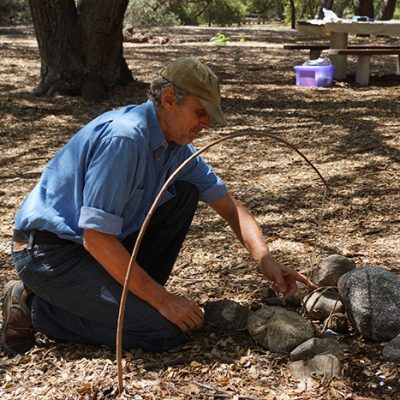
Traps and triggers:
In this more-focused category of weaponry, you will learn how to select woods for making triggers. You will learn by doing, and you will cut and make a simple promontory peg for a deadfall. You will also carve a figure 4 deadfall trigger. You will cut the pieces for the Figure 4 deadfall trigger step by step, and you will set it up with a weight so you learn how such a trigger is actually used in the field. You will construct a traditional quail trap, and learn how to make the scarf trigger that is usually used on this form of a deadfall trap. You will also learn how to make a simple sling, and will be shown other silent weaponry systems. Note: We do not attempt to capture any animals at our classes. We are only teaching the techniques for creating primitive traps for your personal edification, especially should you ever need this information in a genuine survival situation. Bring your knife. In this class you will learn: • How to make the promontory peg. • How to carve all parts of the Figure 4 deadfall. • How to set up a quail trap. • How to carve the scarf trigger for a quail trap.
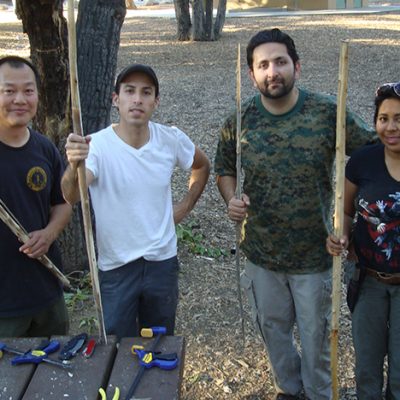
Bow making:
Learn the principles of how to make a self-bow – a one piece long bow. We start you with a dried length of wood, which you then carefully split, and then carefully reduce little by little in the appropriate way until you have a bow. You’ll learn by doing. The concepts you’ll learn are the belly vs the back of a bow, how to tiller, how to make nocks, making the cord, etc. Bring whatever wood reduction tools you have, such as a clamps, draw knife, planer, sandpaper, knife, etc. If you have no tools, don’t worry as we bring supplies. Our goal is to teach you all the principles of how to make a good self bow properly. You may, or may not, end up taking a bow home.
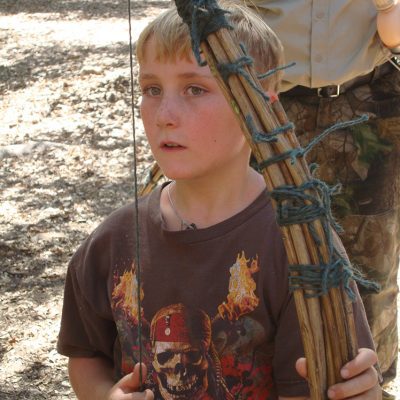
Quick bow:
In this shorter class, you will learn how to create a bundle bow from twigs. A bundle bow is inferior to a properly-made long bow, but is still useful for target practice or for taking small game.
Traditional Arrow making:
Making straight arrows is a survival skill that is essential to the art of archery and bow-making. We will share the many historical styles that people throughout history have employed.
There are many separate aspects to making a traditional arrow from scratch. The arrow is arguably much more complex than the bow.
We begin with the shaft of the arrow, and which woods make the best arrows. We will also discuss modern substitutes, though our focus will be on the traditional arrow.
You will go through each step of arrow-making, beginning with how to straighten the shaft, and how to then prepare it to receive a stone point, and how to create the nocks. You learn how to secure a point using glues, sinew, or artificial sinew, looking for the most efficient method under your circumstances. We will address how to select, trim, and secure the feathers to the arrow, should you choose to use feathers.
A simpler arrow is also made. Bring your knife.
In this class you will learn:
o The ideal woods to use for arrow shafts
o How to propel arrows from a bow, an atlatl, or a caster
o How to straighten the shaft
o How to attach points, or not
o How to prepare feathers for fletching
Cross bow making:
The cross-bow is an old weapon used the world over. It looks like a bow strapped onto a rifle stock. We make a simple cross-bow and trigger from harvested wood, and teach you how to refine it and use it. This is a several hours project. Bring whatever wood-working tools you have.
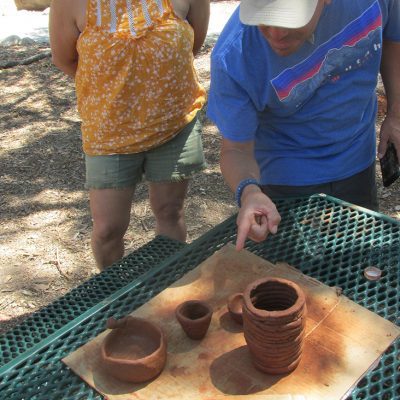
Harvesting and working with clay:
We harvest local clay so you’ll get to see how to identify good clay deposits. You’ll learn the different ways to process clay (wet or dry), and then how to make useful products from the clay, such as plates, bowls, weights, etc. Note: We do not do firing at this class.
Making Clothing:
We offer a few workshops where you learn to follow a pattern and make vests or coats or full-length capotes. These can be done with recycled fabric, leather, or cotton. Bring scissors.
Making yucca sandals:
There are two traditional yucca sandals, the Chumash-style and the Mogollan style. You will learn how to collect and process the yucca, and the process for making each style of these sandals.
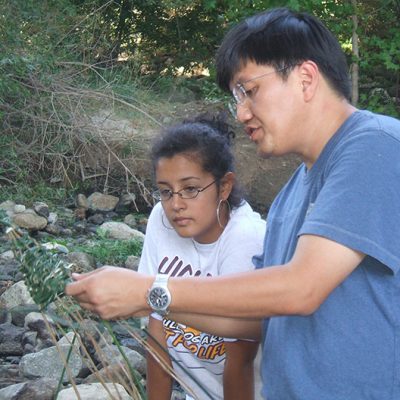
Basketry:
Learn the basic California weave for making a simple basket, either round or rectangular. You’ll learn how to process the raw material, prepare it, and how to create a basket you can use.
Working with soapstone:
Soapstone is a relatively soft stone that can be worked with a knife. You receive a piece of soapstone and your job is to carve it into a bowl, a weight, a pipe, or some device of your choice. Bring your knife, and sandpaper.
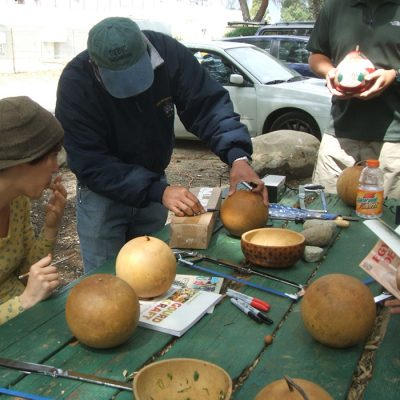
Gourd workshop:
The ornamental gourd has long been used in the Southwest for bowls, cups, spoons, and more. In this workshop, you’ll receive instruction on how to clean your gourd, and how to cut it the most efficiently. You’ll learn how to clean the inside, how to smooth the edge, and how to decorate it, if you so choose. This is a great skill. Bring your knife, and hacksaw if you have one.
WILDERNESS SURVIVAL SKILLS
These are stand-alone classes. Classes in this category include the following. Nearly all classes also include some wild plant identification, and often includes a segment on fire-making.
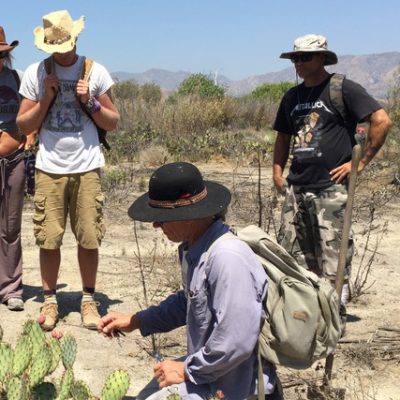
Survival Skills Intensives:
These is a longer class where, during the course of exploring a canyon or open area, you get exposed to nearly all the essential skills, such as edible wild plant identification, cooking with wild plants, primitive and modern fire-making, water purification, shelter-building, making cordage from plants, snaring and trapping.
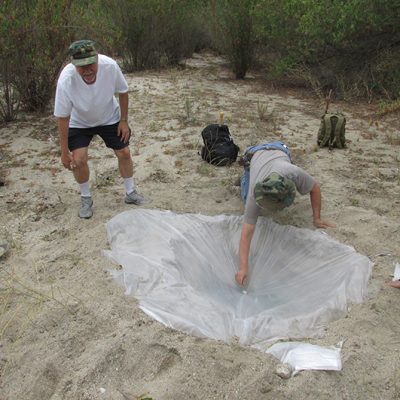
Desert survival skills:
In this class, we focus upon the essential skills for surviving in the arid desert, such as how to obtain water from a still or a transpiration bag, how to dress in the desert, shelter-making, using the cactus for food and medicine, and other related skills.
Shelter workshops:
In the shelter workshop, you will work on making one or more shelters, such as the body- hollow, the lean-to, and the traditional half-dome shelter once used by local natives. You’ll also see how to construct some modern tents, including the tube tent, hammock, tarp-tent, and a pop-up.
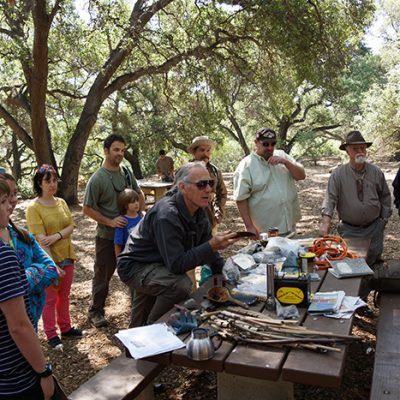
Fire workshops:
Our fire workshops are not spectator events; you will learn by doing. You’ll see us make fire and then you’ll get a chance to try, using both modern and primitive methods. You’ll see all the details of each procedure and be coached to create your own fire using only natural principles.
Navigational skills (map and compass, etc.)/ Orienteering:
In our basic Navigational class, you’ll learn how to identify key star constellations and the north star, how to make a sun-compass, how to read a map, how to use a compass, how to align the map with (and without a compass), and more. Bring a compass if you have one.
Night walks:
During our New Moon or Full Moon walks, you’ll get to experience nature in a different way: Without a flashlight, you will discover that your range of vision is greater than you expected, if you give it a chance. You will learn to hear more acutely, with a few tricks. You will be encouraged to smell leaves, and smell the air. You will learn how to recognize the North Star, and some constellations that can help you with night navigation.
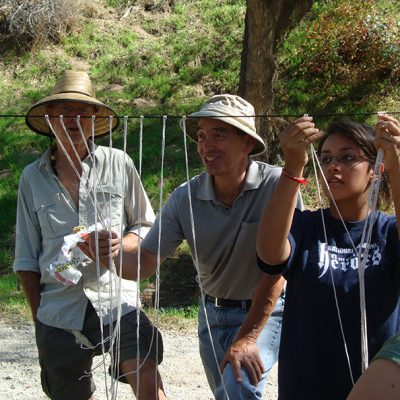
Weaving workshops:
Ancient societies were literally and figuratively “tied together” with fibre. Join us and learn what we mean by this. You’ll discover how to process natural plant fibres into cords or threads, and how to make those into rope, brushes, sandals, baskets, nets, and more. Sometimes, there will be a narrow focus, such as making a basket, or making sandals.
Tracking fundamentals, and workshop:
You’ll learn the common tracks from the most common animals in the area we’ll be working, and how to “read” the tracks. You’ll learn what to look for to see how long ago the animal came by, where it was going, was it young or old, was it in a hurry or taking its time, etc. Another “lost art” that everyone in the past took for granted.
URBAN PREPAREDNESS AND SURVIVAL SKILLS
These are stand-alone classes. Classes in this category include the following. Nearly all classes also include some wild plant identification, and often includes a segment on fire-making. In this category, we offer classes that include those skills you should know when the power goes out and you have to rely on your wits in the urban setting.
Earthquake preparedness:
Taught in seminar style, we will address the most common concerns of earthquake planning, and post-earthquake living: Water storage and purification, food storage, and backyard cooking, toilet alternatives, manual alternatives to electrical devices, lighting, security, warmth.
Locksmithing:
Locksmithing is a valuable skills in good times and bad. If you just can’t get a locksmith, you should know some of the basics of how a lock works so that you could pick it and gain entry if needed, without having to break a window or kick in a door. Class includes pick and rake.
Food storage basics:
For those who want to focus upon home food preparedness, we discuss how to organize your food storage, and how to decide what to store. We focus primarily upon those foods that do not require refrigeration, such as canned goods, dry goods, beans, grains, pasta, pickled food, etc. We teach you how to process various foods for home storage, so you can save money from buying commercially-prepared foods for storage. How to cook your stored food is included, as is how to store water.
Tools and weaponry for the home:
In this seminar-style class, we focus upon how you devise your own home security system based on your needs and your circumstances. Then, we discuss mandatory tools that should be in every home, especially for disaster planning. We will also discuss your weaponry choices for self-defense, such as the options of noise-makers, smoke-producers, long guns (shot, rifle, air), and the various sizes and options in revolver vs. semi-auto.